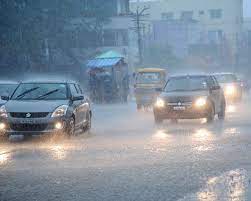
Introduction
The state of Tamil Nadu falls in the southern India region and is highly vulnerable to its monsoon seasons. The rainfall state of Tamil Nadu is mainly received through the northeast monsoon, which occurs between the months of October and December. These rains have been important for agriculture, water storage, and the livelihood of millions spread across the state. Similarly, the floods and partial structural damages to infrastructure due to rains in Tamil Nadu also create problems besides hindering day-to-day life. It is very crucial to have knowledge of the importance of Tamil Nadu rains, its pattern, benefits, and drawbacks to attain insight into state socio-economic and environmental equilibrium.
Tamil Nadu Rainfall Pattern
Unlike most parts of India which derive their rain mainly from southwest monsoon, Tamil Nadu receives its rainfall mainly by northeast monsoon. Southwest monsoon contributes a minuscule portion i.e., 35% of the annual rain to Tamil Nadu state which falls mainly in the mountainous and coastal regions. Tamil Nadu’s total rainfall is derived mainly by northeast monsoon that is 65%.
Northeast Monsoon
Northeast monsoon usually sets itself in the last week of October and runs until December. The rainy season is generally quite wet, especially over coastal regions. Cyclical depression of the Bay of Bengal, mostly originating from the east, causes heavy rain in the state of Tamil Nadu. Northeast monsoon contributes as a major source of water for Tamil Nadu’s agriculture, rivers, and reservoirs and therefore forms a prerequisite in the state’s water security.
Southwest Monsoon
Tamil Nadu receives only minor southwest monsoon showers that affect the north and west regions of the state. The Nilgiris, Coimbatore, and parts of Chennai experience showers during this season, but it plays a minor role for the northeast monsoon season for the water management system of the state.
Importance of Rainfall for Agriculture and Water Resources
Tamil Nadu is basically an agricultural state and the rains have a vital impact on the agricultural productivity. The northeast monsoon supports these crops of great importance like paddy, sugarcane, and pulses. The states of Tamil Nadu have some rain-fed rivers like the Cauvery, Vaigai, and Tamirabarani, entirely dependent on the monsoon rains to maintain uninterrupted flow.
Rainfall also recharges the state’s water reservoirs. Major dams and reservoirs have been developed in the state, such as the Mettur Dam and Vaigai Dam, to store water for irrigation and drinking purposes. During adequate rainfall periods, these reservoirs fill up with water that can be availed throughout the year for agriculture, industries, and household purposes. The poor monsoon rains result in drought, which adversely affects agriculture, water supply systems, and hydroelectric power generation.
Difficulties Presented by Heavy Rains
Though rain is crucial to the state’s economy and ecosystem, heavy downpours pose some serious difficulties. Flooding, waterlogging, and damage to infrastructure are common consequences of heavy downpours.
Urban Flooding
Cities in Tamil Nadu, especially Chennai, have been under severe urban flooding for some years. Most prominently, it occurred in 2015 as the torrential rain wrecked the drainage system of the city, leaving the city devastated with huge destruction and loss of life. The contributing factors were mainly rapid urbanization, unplanned constructions, and encroachments over water bodies. It has been causing obstruction of the natural flow. Urban cities are easy victims of floods.
Rural Flooding
Rural areas are equally prone to the impacts of heavy rains. Crop damages and soil erosion are the most commonly seen effects of heavy rainfall in farming areas. Not taking proper care about the irrigation system and drainage channels further exacerbates the problem by waterlogging the fields and destroying the standing crops. The floods flood the villages which lie on river banks due to increases in water levels caused by heavy rainfall at upstream.
Infrastructure Damage
Intense rains cause destruction of roads and bridges and buildings. In the countryside, kutcha roads (roads which are unpaved) get impassable and would cut to roads health services and local markets. Water-logged streets, blocked drains, and craters scatter urban streets and streets. In the coastal districts of the country, the impact of cyclones and storm surges during the monsoon season adds yet another layer of damage cut to homes, infrastructure, and power supplies.
Public Health and Safety Impact
Extremely heavy rainfalls along with inadequate infrastructure can really pose a significant hazard to public health. Flooding usually results in the contamination of sources of drinking water, which increases outbreaks of water-borne diseases such as cholera, typhoid, and gastroenteritis. Overturned water also serves as breeding grounds for mosquitoes, increasing the incidence of vector-borne diseases like malaria and dengue. Public health systems, already stressed across many districts in Tamil Nadu, become highly congested during the monsoons.
Displacement and Relief Work
Many thousands of people, especially in slum and low-lying areas, are left to flee their homes during flooded conditions. Emergency relief activities, such as food, water, and medical supplies, are the immediate needs. Still, it is challenging for a government agency to coordinate these relief activities because of destroyed infrastructure and the massive number of people brought about by the flooding.
The Role of Government and Civil Society
Although the government of Tamil Nadu is critical in managing the stresses brought about by the rains during monsoons, equally important to note is the role played by organizations in civil society. While the government has agencies like the Tamil Nadu State Disaster Management Authority which engages in flood preparedness measures and observes patterns of rainfall among other interventions during emergencies, there are recent technological tools in the form of weather forecasting, flood modeling, and early warning systems which have heightened the state’s capacity to resist the impacts of heavy rains.
Relief efforts by communities and NGOs during floods, campaigns to raise public concern and improve the risk of floods, and advocacy for sustainable urban planning that reduces these vulnerabilities are also important at the local level. Restoring encroached natural drainage channels and water bodies in urban areas will help manage rainwater better during the monsoon.
End
In Tamil Nadu, weather patterns are erratic and extreme, where climate change has advanced to such a degree that monsoon rains are becoming unpredictable. Thus, it is downpour in some years, whereas in others there is no rain at all. Adaptation measures such as rainwater harvesting, sustainable urban planning, and better management of resources can reduce adverse effects brought by changed rainfall patterns.
Conclusion
The rains in Tamil Nadu are as much a blessing as they are a challenge. They sustain its state agriculture, fill up its reservoirs, and maintain its rivers. But along with all these, they bring a threat of floods and physical destruction along with the gridlock due to deteriorating infrastructures, deterioration of public health, all the more in recent times of urbanization and climate change. The way forward from the monsoon rains of Tamil Nadu, therefore, is a more holistic approach of planning and infrastructure development with proactive approaches toward disaster preparedness. It can grapple with its main challenges so that it can reap the medicinal water-giving nature of its rains without their risks.




